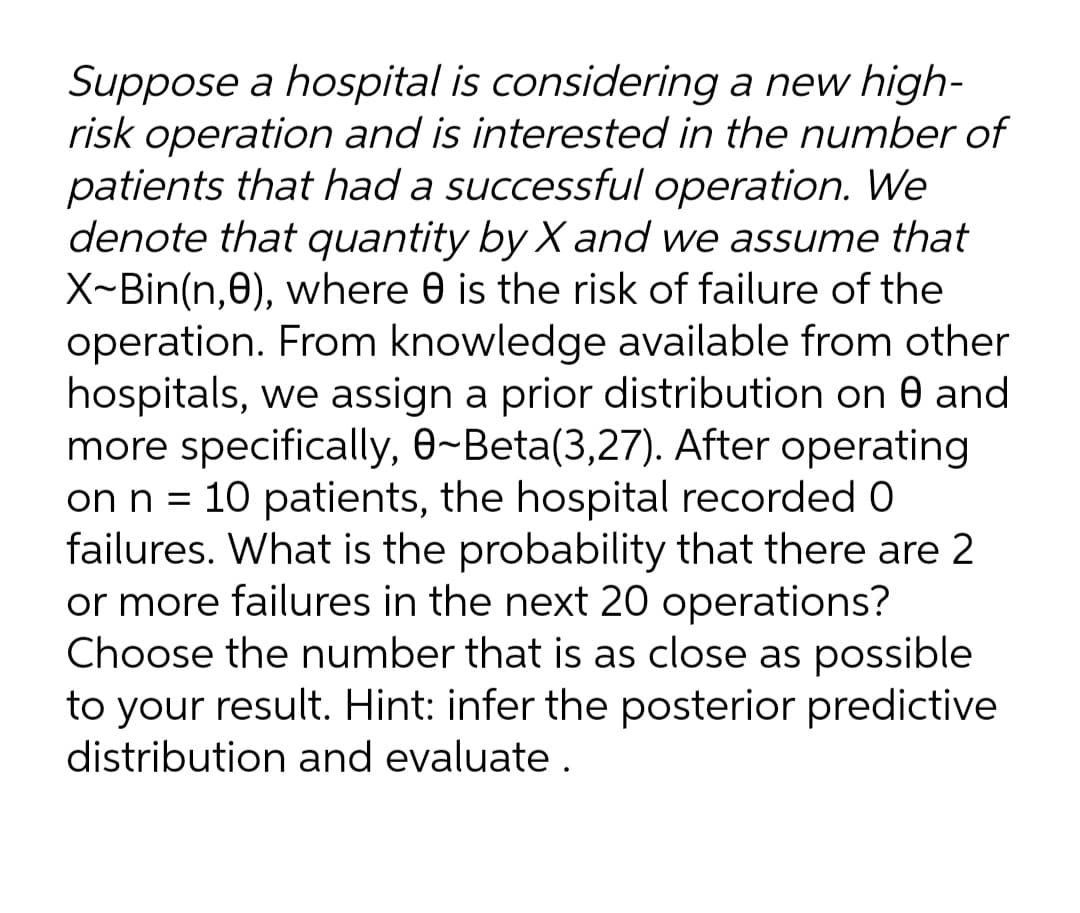Suppose a hospital is considering a new high- risk operation and is interested in the number of patients that had a successful operation. We denote that quantity by X and we assume that X~Bin(n,0), where 0 is the risk of failure of the operation. From knowledge available from other hospitals, we assign a prior distribution on 0 and more specifically, 0-Beta(3,27). After operating on n = 10 patients, the hospital recorded 0 failures. What is the probability that there are 2 or more failures in the next 20 operations? Choose the number that is as close as possible to your result. Hint: infer the posterior predictive distribution and evaluate .
Suppose a hospital is considering a new high- risk operation and is interested in the number of patients that had a successful operation. We denote that quantity by X and we assume that X~Bin(n,0), where 0 is the risk of failure of the operation. From knowledge available from other hospitals, we assign a prior distribution on 0 and more specifically, 0-Beta(3,27). After operating on n = 10 patients, the hospital recorded 0 failures. What is the probability that there are 2 or more failures in the next 20 operations? Choose the number that is as close as possible to your result. Hint: infer the posterior predictive distribution and evaluate .
Algebra & Trigonometry with Analytic Geometry
13th Edition
ISBN:9781133382119
Author:Swokowski
Publisher:Swokowski
Chapter10: Sequences, Series, And Probability
Section: Chapter Questions
Problem 27T
Related questions
Question

Transcribed Image Text:Suppose a hospital is considering a new high-
risk operation and is interested in the number of
patients that had a successful operation. We
denote that quantity by X and we assume that
X~Bin(n,0), where 0 is the risk of failure of the
operation. From knowledge available from other
hospitals, we assign a prior distribution on 0 and
more specifically, 0~Beta(3,27). After operating
on n = 10 patients, the hospital recorded 0
failures. What is the probability that there are 2
or more failures in the next 20 operations?
Choose the number that is as close as possible
to your result. Hint: infer the posterior predictive
distribution and evaluate.
Expert Solution
This question has been solved!
Explore an expertly crafted, step-by-step solution for a thorough understanding of key concepts.
Step by step
Solved in 2 steps with 2 images

Recommended textbooks for you

Algebra & Trigonometry with Analytic Geometry
Algebra
ISBN:
9781133382119
Author:
Swokowski
Publisher:
Cengage

Algebra & Trigonometry with Analytic Geometry
Algebra
ISBN:
9781133382119
Author:
Swokowski
Publisher:
Cengage